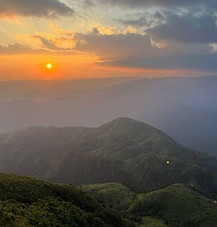
Fauna and flora in India
Home > Things to see > Flora and fauna
An unparalleled biodiversity
India is more than just a unique culture, one of the world's oldest civilisations and the world's largest population. The country also boasts remarkable flora and fauna. Thanks to its diversified topography and climate, the country's biodiversity is incomparable. Aware today of the importance of protecting this rich heritage, India has a hundred or so national parks, some of which are listed as Unesco World Heritage sites. These allow travellers to discover, in the best possible conditions, the country's abundant vegetation and the many animal species they shelter. From the lush mangroves of the Sunderbans to the sandy Thar desert of Rajasthan, from the sals forests of Madhya Pradesh to the rocky mountains of Ladakh, many species, large and small, make up one of the richest biodiversities in the world: around 420 species of mammals, 1330 species of birds, 518 varieties of reptiles, 425 types of amphibians and 2550 species of fish.
 |  |  |
|---|---|---|
 |
Observe the fauna and discover the flora of India
Among the most emblematic species, the elephant occupies a special place. Sacred and revered, the country takes great care of the pachyderm, which, domesticated or wild, will inevitably be in the path of travellers to India. The tiger, also elected national animal, is just as much in demand and a visit to a national park will, in most cases, provide the long-awaited encounter. Other species such as the Asiatic lion, crocodile, leopard, antelope, one-horned rhinoceros and cobra are more localised and will require a longer, more focused trip to see them. The peacock, India's emblem, is sometimes seen in hotel gardens, while the monkey, also sacred and venerated, is more present in towns, particularly in parks or near temples where it is fed by the locals. The diversity of habitats and climates also makes India a paradise for birdwatchers, who can observe around 1,250 species of birds, both migratory and permanent residents.
With the lotus as its national flower, India's flora is one of the most diverse in the world, thanks to a wide variety of climates, topologies and habitats. The country has more than 18,000 species of flowering plants, representing around 6-7% of the world's plant species. In all, India is home to more than 50,000 plant species, many of which are endemic. India's plant biodiversity is not only important for its ecosystem. Playing a crucial role in traditional medicine, agriculture and the daily lives of local populations, thousands of initiatives are being undertaken here and there to preserve biodiversity and bring citizens closer to nature. For instance, thousands of trees are being replanted in Uttar Pradesh and the Sunderbans mangrove is being tended by hundreds of women. The use of plants for medicinal purposes has been part of Indian culture since time immemorial. More than 3,000 of them are officially listed, divided into several floral regions. Many varieties are used in Ayurvedic treatments during wellness or fitness holidays in Kerala.

Bhandavgarh National Park
Madhya Pradesh
It is one of the most popular parks because of its high biodiversity and because it has one of the highest tiger densities in the country.
Declared a national park in 1968, it now covers an area of 1,536 km², with a core area of 716 km². Until 1947, the park remained a favourite hunting destination for the maharajas and their guests. But since 1972 and the introduction of 'Project Tiger' and the Wildlife Protection Act, many measures have been taken to preserve the natural habitat, thus protecting the species.
With the tiger as the main 'attraction', the park is home to 37 species of mammals and, according to official sources, over 250 species of birds, about 80 species of butterflies and a number of reptiles. Among the rarest are the leopard and the lippu bear. Among the most seen are the spotted deer, sambar, Indian entelle (monkey), caracal (desert lynx), Indian fox, mongoose, Indian buffalo, nilgai (antelope), etc.....
The vegetation and flora of the park consists mainly of sal forests in the valleys and bamboo on the slopes. The vegetation along the streams and swamps is rich in birds, including crested eagles and storks. Among the most frequently encountered are the great spotted grebe, the white-eyed harrier, the bankiva rooster, the snake watch and the peacock, the emblem of India.
Finally, the reptilian fauna includes the cobra, the Indian bongar, the viper, the python, the Aesculapian snake and many varieties of lizards including the monitor.
Preserving India's biodiversity
Despite their richness, India's flora and fauna are threatened by demographic expansion, agriculture and habitat destruction. However, the authorities are actively working to protect this natural heritage. Today (November 2023), India has more than 106 national parks covering an area of 44,403 km², or 1.35% of the country's total surface area. Thanks to improved infrastructure, better controlled activities, appropriate support and increased awareness, travellers will be able to explore these parks in an environmentally friendly way. We invite you to discover these protected areas, havens of biodiversity. All you have to do is choose your destination to satisfy your curiosity and help preserve this incredible natural wealth.







